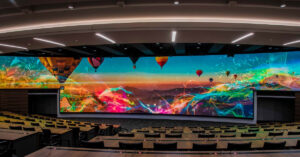
Size Matters
Published February 3, 2020

Have you ever been in a presentation and could barely read anything on the screen? It’s like playing Where’s Waldo without any of the fun. Maybe you interrupted the presenter and asked them to zoom in. If they did, they may have struggled to find the right tools to navigate and constantly had to pan and zoom. That can get sickening for some people.
Or maybe they kindly told you to move to the front row, which is just way too close and you would have to crane your neck to see. So, instead, you stayed put because you’ve already had the perfect note taking set-up in the back row, right next to the heater vent. You’d rather be warm than see, so most likely, you just squint your eyes, lean forward without making it too obvious, give up, and just listen. And in the end, you wonder how much of the presentation you missed. Those small numbers and words weren’t that important, right?
Size does matter. Especially when it comes to the size of your presentation display. Picking the right size for your space allows the audience to get the same experience wherever they decide to sit. And let’s be honest, everyone has their “spot” and a hundred reasons why it’s better than another. Searching for a uniform user experience for your presentation begs the question; how do I pick the right size for my presentation display?
You could play the guess and check game by putting up various displays but we have a solid answer to prevent you from doing extra work. Whether talking about monitors, displays, LED walls, or projection, the answer is several standards set forth by AVIXA and SMPTE. These national associations identify equations and a visual acuity multiplier for different viewing situations based on the Snellen eye chart, the white chart with the big E at the top you see at the eye doctor.
To ensure the image is large enough to get your message across, we get to ask several questions. What exactly are you presenting most of the time? Are you presenting a simple slide show, detail oriented material, or full motion video like at the cinema? How close will a person be viewing? How far away will a person be viewing? Are the viewers all watching straight on or from various angles? Have you considered ADA compliance?
These are the questions we normally ask when heading into a new space. The standard gives us a great starting point for helping you pick the right size display or projection surface for your presentation or performance space. In the coming years, following these standards will become even more vital as the workplace and classrooms continue to move away from single source displays to multi-source, multi-display to create a fully immersive and collaborative space for sparking creativity and increasing productivity.
If you’re interested in learning more about this digital canvas of the future or just finding the right size screen for your space, we’d be happy to talk! Please send us an email or give us a call.
Get Expert AV Assistance
Latest Blogs
About Arrow AV Group
We are a premiere audiovisual integration firm serving corporate, government, healthcare, house of worship, and education markets with easy-to-use solutions that drive success. Family-owned and operated from Appleton, WI for over 35 years.




